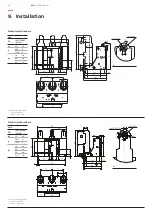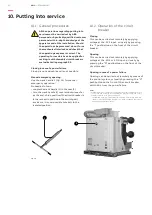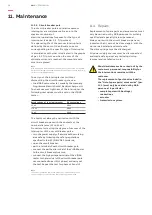
M ED I U M VO LTAG E P R O D U C T S
53
53
10.3. Operations before putting
into service
Before putting the circuit breaker into service,
carry out the following operations:
•
remove the lifting hooks;
•
check tightness of the power connections at the
circuit breaker terminals;
•
establish the setting of the primary electronic
overcurrent release (if provided);
•
check that the value of the power supply voltage of
the auxiliary circuits is between 85% and 110% of
the rated voltage of the electrical accessories;
•
remount any covers removed during the testing
operations;
•
check that no foreign bodies, such as bits of
packing, have got into the moving parts;
•
remount the covers which may have been removed
during the testing operations;
•
check that there is a sufficient exchange of air in
the installation place to avoid overtemperatures;
•
supply the auxiliary circuits with power;
•
supply the -SO4 input (opening function for
undervoltage) and the -SL1 input (lock on closing
function) before carrying out the closing
operation;
•
check the functionality and efficiency of the
mechanical and electrical locks;
•
carry out a few circuit breaker opening and closing
operations by means of the pushbuttons on the
front of the circuit breaker;
•
in the case of a circuit breaker with motorized
isolation, check the direction of motor rotation
and the direction of truck racking-in/racking-out;
•
also carry out the checks indicated in table T3.
T3
Item inspected
Procedure
Positive check
1
Insulation resistance.
Medium voltage circuit
With a 2500 V megger, measure the insulation resistance
between the phases and the exposed conductive part of the
circuit.
The insulation resistance should be at least 50
Mohm and in any case constant over time.
Auxiliary circuits
With a 500 V megger (if the apparatus installed allows this),
measure the insulation resistance between the auxiliary circuits
and the exposed conductive part.
N.B. Before carrying out the test, disconnect the earthing of the
electronic card from the circuit breaker frame and reconnect it
after the test.
The insulation resistance should be a few Mohm
and in any case constant over time.
2
Auxiliary circuits.
Check that the connections to the control circuit are correct:
proceed with the relative power supply.
Operations and signals are normal.
3
Auxiliary contacts in the drive.
Insert the auxiliary contacts in suitable signalling circuits.
Carry out a few closing and opening operations.
The signals take place normally.
4
Locking electromagnet on the
circuit breaker truck (-RL2)
With the circuit breaker open, in the isolated for test position,
and the locking electromagnet not supplied, attempt to rack in
the circuit breaker.
Supply the locking electromagnet and carry out the racking-in
operation.
Racking-in is not possible.
Racking-in takes place correctly.
5
Auxiliary transmitted contacts
signalling circuit breaker
racked-in, isolated (UniGear
switchgear or PowerCube
modules).
Insert the auxiliary contacts in suitable signalling circuits.
With the circuit breaker racked into the enclosure, carry out a few
traversing operations from the isolated for test position to the
racked-in position.
Take the circuit breaker to the racked-out position.
The signals due to the relative operations take
place regularly.
Содержание VM1
Страница 59: ...MEDIUM VOLTAGE PRODUCTS 59 59 ...






































